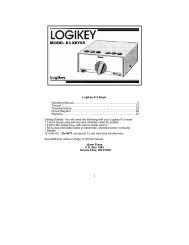4-BTV, 5-BTV, 6-BTV Multiband HF - K6RF Home of the Porta Base ...
4-BTV, 5-BTV, 6-BTV Multiband HF - K6RF Home of the Porta Base ...
4-BTV, 5-BTV, 6-BTV Multiband HF - K6RF Home of the Porta Base ...
Create successful ePaper yourself
Turn your PDF publications into a flip-book with our unique Google optimized e-Paper software.
The Quarter-Wave Vertical on a Metal Ro<strong>of</strong><br />
Over <strong>the</strong> years, many Amateur Radio operators have successfully used a metal ro<strong>of</strong> as <strong>the</strong> ground<br />
plane or radial system for <strong>the</strong>ir quarter-wave <strong>HF</strong> vertical antenna. This is possible with a metal ro<strong>of</strong><br />
on a home, barn, garage, carport, RV, porch and metal sheds or awnings, and even on commercial<br />
buildings. The actual height <strong>of</strong> <strong>the</strong> metal ro<strong>of</strong> above ground is not especially important for an <strong>HF</strong><br />
quarter-wave vertical antenna.<br />
In order to take advantage <strong>of</strong> a metal ro<strong>of</strong> as a ground plane, you cannot elevate a quarter-wave<br />
vertical high above a metal ro<strong>of</strong>. The key is that <strong>the</strong> antenna feedpoint, which is usually at<br />
<strong>the</strong> mounting bracket, should be <strong>the</strong> same physical level as <strong>the</strong> metal ro<strong>of</strong> to <strong>of</strong>fer <strong>the</strong> best ground<br />
plane effect.<br />
The feedpoint <strong>of</strong> <strong>the</strong> vertical should not be any more than 4 to 8 inches above <strong>the</strong> ro<strong>of</strong>, even if <strong>the</strong><br />
mechanical mounting would allow for a higher installation. In o<strong>the</strong>r words, raising a quarter-wave<br />
vertical antenna many feet above <strong>the</strong> metal ro<strong>of</strong> does more harm than good with regard to<br />
impedance matching and tuning. Mounting <strong>the</strong> <strong>HF</strong> quarter-wave antenna at <strong>the</strong> top <strong>of</strong> a tall mast,<br />
without a feedpoint level radial system, does not function electrically, and is mechanically very<br />
difficult. If you must use a tripod for mechanical mounting reasons, use one that is as short as<br />
possible. With a tripod mount, you must use a basic wire radial system that emanates from<br />
that slightly elevated feedpoint and drapes down over <strong>the</strong> metal ro<strong>of</strong> to make use <strong>of</strong> <strong>the</strong> coupling<br />
effect described below. You cannot make a direct connection <strong>of</strong> <strong>the</strong> coax shield to <strong>the</strong> metal, due to<br />
<strong>the</strong> distance <strong>of</strong> <strong>the</strong> feedpoint above <strong>the</strong> metal.<br />
There are two ways that a quarter-wave vertical can be installed on a metal ro<strong>of</strong> or large metal<br />
awning as a ground plane.<br />
The potentially less efficient installation uses direct grounding <strong>of</strong> <strong>the</strong> coax shield and antenna<br />
bracket to <strong>the</strong> metal ro<strong>of</strong>. This might work well for transceiving, and would probably "appear" to<br />
work well due to excellent receiving results. However, you may find that you aren't easily heard.<br />
This would be an indication that <strong>the</strong> sections <strong>of</strong> your metal ro<strong>of</strong> are not well bonded. Remember, we<br />
are trying to provide <strong>the</strong> same low impedance RF current collection and distribution as a ground<br />
mounted system <strong>of</strong> 30, or more, straight copper wire radials that are about one-quarter wavelength<br />
long. Just because <strong>the</strong> metal panels <strong>of</strong> a metal ro<strong>of</strong> are connected with a bunch <strong>of</strong> screws or nails,<br />
and even when a multi-meter shows DC continuity between <strong>the</strong> panels, does not mean that you have<br />
a good radial system for RF. You can try it and believe that it is working great, but you may not<br />
really know how efficient <strong>the</strong> directly connected metal ro<strong>of</strong> is working for you. Measured at <strong>the</strong><br />
antenna, a frequency range <strong>of</strong> over 400 kHz under a 2:1 SWR across and beyond <strong>the</strong> 40 meter<br />
band (7.0 to 7.4 MHz) would be a general indication <strong>of</strong> radial system or ground plane inefficiency,<br />
depending upon <strong>the</strong> size <strong>of</strong> <strong>the</strong> vertical. Conversely, a very efficient ground plane will narrow <strong>the</strong><br />
SWR bandwidth <strong>of</strong> a vertical, as narrow as 150 kHz on <strong>the</strong> 40 meter band on <strong>the</strong> <strong>BTV</strong> series<br />
antennas.<br />
The preferred installation for your quarter-wave vertical using a metal ro<strong>of</strong> or large awning as your<br />
ground plane is to connect <strong>the</strong> coaxial cable shield to several (6 to 16) insulated radial wires that are<br />
placed on, under, or are draped out over <strong>the</strong> metal ro<strong>of</strong>. The radials must be attached to <strong>the</strong> antenna<br />
feedpoint, never at <strong>the</strong> bottom <strong>of</strong> a tall mast or tripod. Capacitive and inductive coupling between<br />
<strong>the</strong> radial wires and <strong>the</strong> metal ro<strong>of</strong> accomplishes <strong>the</strong> collection <strong>of</strong> <strong>the</strong> RF currents. The number <strong>of</strong><br />
- 46 -



